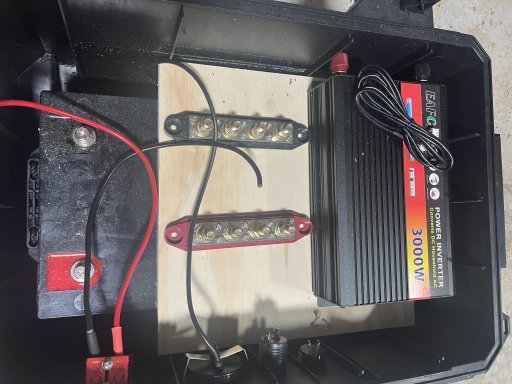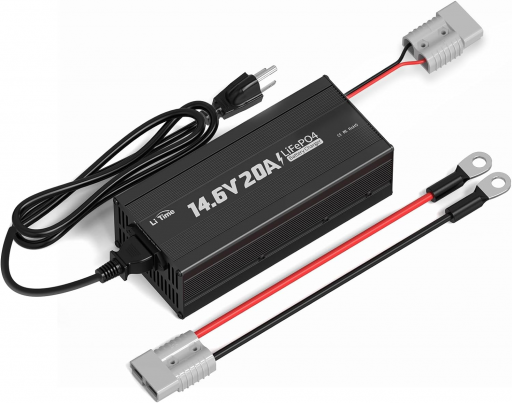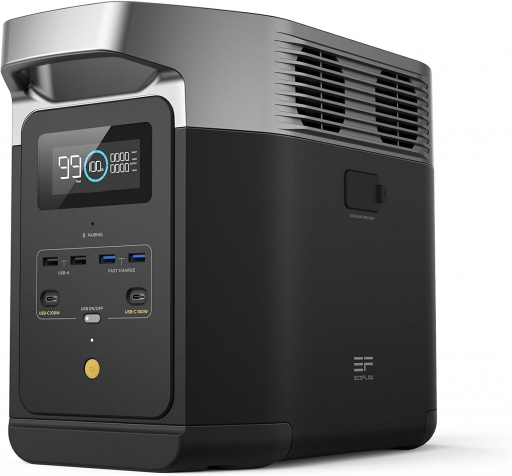I am just thinking of getting my leisure battery to power my trailer systems- cooler,car stereo,,interior lights and external flood lights. Before I do I am looking at power stations,which I know very little about. Is it possible to power my trailer systems with a power station in a similar fasion to a leisure battery? Can you get power stations with DC terminal connection? How many amps DC do they generally supply?
Portable power station to power trailer systems??
- Thread starter tyndall
- Start date
-
Guest, UPDATE We went through the site migration runbook and completed all steps. We will need to complete the migration next week, but will leave the forums up for the weekend. A few days after maintenance, a major upgrade revision to the forum site will occur.
Good ones do 30A dc. Most do 10 to 15A though. Here, read my thread on good power starions, the ones I pick have the best dc output.

 forum.expeditionportal.com
forum.expeditionportal.com

Good Solar gen Power Stations for DC and light AC Truck Campers
This thread is to help consolidate info on what solar generators also called power stations, will work well for small truck popup campers who plan on using some light 120Vac cooking tools (like Tune M1, OVRLND, AT Summit, GoFast, Topo Toppers, Project M, Hiatus, LonePeak, Super Pacific, etc.)...
 forum.expeditionportal.com
forum.expeditionportal.com
If you want single port plug in for all your 12v needs and then build the distribution system Into the trailer you will want an XT60 30a port on it like is found on a Pecron E1500lfp

Member III
- 2,268
- First Name
- Scott
- Last Name
- Viking
- Member #
-
17968
- Service Branch
- Air Force Veteran
Thanks, I'll definitely be watching this thread so I can go back to it when I'm ready to get a new power station or build my own again!
Having a 6’ tall wife I can agree ,bigger is better. I’m not sure her charging port will accept a solar panel…
Hey, with enough imagination...Having a 6’ tall wife I can agree ,bigger is better. I’m not sure her charging port will accept a solar panel…
I power my squaredrop with a Bluetti AC180 (we call it the bluetittie), using the cigarette port (10A) tied to a buss, which in turn is tied to all the stuff. 2 LED reading lights, a larger overhead LED light, a vent fan, a small LED light in the galley, and a Setpower PT55 at full power drew 76W. I have not yet tested the AC stuff (kettle, radio charger, etc...)
I had some serious power station decision burnout by the end there so I went with the 50% sale, or whatever it was at the time.
yeah, really easy to do and by making your own with the rolling tool tote, you can start with a smaller battery and add or go bigger as you need and its really easy to wire an extra port or make mods easily. i do recommend incorporating a battery monitor with a shunt. the shunt is a device that will monitor current flow in AND out of the battery so you have a very accurate readout of your battery status at any given moment. not a huge deal, but i really like having it. with the anderson plug, i can plug into solar or use the mains to recharge the battery, so when out boondocking, i can just hook directly up to my camp trailer solar and charge during the day while we're out hiking and then use the same connector to power higher amp devices like inverters, etc.The ecoflow has good reviews on Amazon .Your home made generator looks great Grub, I might have to build one as a project
we live on the coast in south louisiana, so lots of hurricanes and power outtages. power goes out and i just walk out to the camp trailer and wheel my tote into the house and i'm ready to operate fridges, freezers off the inverter and i have usb ports to run a bunch of different led lights that are wired for usb. also have the cigarette lighter port to run my 12v fans at night. i have several 100ah lipo batteries and i went ahead and got a 280ah to use in the tote. like i said earlier, thats over 3000wh, so my DIY power station cost about $600 and buying a power station in the 3000wh range will go a minimum of $2000, so a really good savings and with the shunt monitor, i'm getting every bit as much info as the factory made units have.
Do you have charge regulators in your unit for mains and solar ? Also your inverter sounds like it’s external to the tote also?
i have several lipo batteries, so i use the one external charger dedicated for lipo that plugs into the mains. it charges at 14.6v and can support up to 20 amps. all my solar setups have their own charge controller, so i have it set up where i can just go to any of my other setups and unplug from that battery and plug in the tote and charge away.Do you have charge regulators in your unit for mains and solar ? Also your inverter sounds like it’s external to the tote also?
the inverter is quasi-internal...meaning that it is in the tote, but i have to open the lid and plug into it. i have the 280ah battery with a piece of plywood on top that i use to mount the bus bars, fuse block, etc. the inverter just sits on top of that and when i need it, i just open the lid and plug into the inverter. i would need more room inside in order to mount and wire in a mains outlet. i dont use the inverter enough to worry about it, but it is there and operational when i need it.
when you get a battery, read and check its charging requirements. i know the last few lipo batteries i bought were 14.6v and up to 20 amp. sounds crazy to me, but yes, these newer batteries are built to get charged very fast without any damage. i forgot the exact specs, but when i bought the special charger, it is supposed to charge the 280ah battery in 2-3 hours i think. whatever it is, i remember it was crazy fast


on all my lipo batteries, i wire in an anderson plug that stays on the battery posts and that way if i ever need to charge with the mains, i can just plug in the charger and directly connect to the battery without having to do any hookups and i certainly wouldnt use alligator clips to make a connection. when messing with lithium batteries, i want a VERY solid connection that has lots of surface area and wont get bumped loose.
Last edited:
Thanks for sharing your build Grub. Im trying to understand lithium battery tech a bit more. I think your battery is a probably a single cell 12v unit? Having watched a few solar generator strip down videos,it seems most off the shelf generators use multiple cells joined together. the cells range in size from D upwards but are mostly 3.2volts-I’m guessing they are wired together to create 12v ultimately . It seems buying cells like this and joining them may be a cheaper option- I wondering if this is the reason they use cells or if there are other advantages to using multiple cells over one big battery? Maybe inside your battery there are multiple smaller cells joined together??
Go to the Will Prowse DIY SOLAR forums, and read the sub forum on diy battery banks. Best info source on web by far. Seems general concensus is prices have dropped so much that diy cell build not worth it unless looking for something nonstandard in total capacity or shape. I mean, Lifepo4 batteries are cheaper than lead acid now! You can get a 100Ah 12.8v v, 150A output, heated, for $229.Thanks for sharing your build Grub. Im trying to understand lithium battery tech a bit more. I think your battery is a probably a single cell 12v unit? Having watched a few solar generator strip down videos,it seems most off the shelf generators use multiple cells joined together. the cells range in size from D upwards but are mostly 3.2volts-I’m guessing they are wired together to create 12v ultimately . It seems buying cells like this and joining them may be a cheaper option- I wondering if this is the reason they use cells or if there are other advantages to using multiple cells over one big battery? Maybe inside your battery there are multiple smaller cells joined together??

DIY LiFePO4 Battery Banks
Advanced user discussion on BMS/ Cell Configurations/ Temperature Regulation/ Cell Sources and more
 diysolarforum.com
diysolarforum.com
none of the batteries are single cell and even lead acid batteries have multiple cells. a battery is basically 2 dissimilar metals (anode and cathode) suspended in an acid solution (electrolyte). say i have a quart mason jar full of electrolyte and i stick in an anode and cathode and measure the voltage i get from the chemical reaction. say its 1 volt. i can add another quart jar and anode and cathode and get 2v. i can also divide the original quart mason jar into 2 pints, break the anode and cathode in half and get 2 volts using the same amount of materials. im only getting a certain voltage from the reaction, so by diving the materials, i can get twice the voltage from the same amount of materials. i will drop my capacity (amps) in half, but basically i can take that original material and keep dividing it until i get 12v and i will pretty much keep the weight the same. not a totally accurate explanation, but you get the idea as to why a battery has multiple cells.Thanks for sharing your build Grub. Im trying to understand lithium battery tech a bit more. I think your battery is a probably a single cell 12v unit? Having watched a few solar generator strip down videos,it seems most off the shelf generators use multiple cells joined together. the cells range in size from D upwards but are mostly 3.2volts-I’m guessing they are wired together to create 12v ultimately . It seems buying cells like this and joining them may be a cheaper option- I wondering if this is the reason they use cells or if there are other advantages to using multiple cells over one big battery? Maybe inside your battery there are multiple smaller cells joined together??
@Dave in AZ just posted a good link and that will help you understand this a bit better. and yes, prices are now so good on lithium batteries that it wouldnt pay to try to build your own battery. it does pay off to make your own power station, but that is as far as i would venture on building my own
i do seriously recommend getting good chargers and charge controllers for lithium batteries. lead acid batteries are simple and very forgiving, but i wouldnt risk cheap chargers and controllers for lithium.
I agree on the Lithium chargers. I kike the Victron IP67, because you can go in and set every possible voltage and time for the recharge to perfectly match your battery. Bulk voltage, fliat voltage, topoff, storage, maintenance... all can be slightly different in various LFPs.
A power station like the OUPES power station can act just like a leisure battery, but with more features built in—like built-in inverters, displays, and multiple output types. Most will have at least one 12V "car port" output and sometimes Anderson or XT60 ports. Amperage varies by model, but many provide 10A–15A from the DC outputs.
Last edited:
My trailer will be powered by a Ecoflow Delta 2 or Delta Pro. We use them as backups at home also, so I wanted something that could easily come out of the trailer when needed. I'm also installing the Ecoflow 800W Alternator Charger to charge while driving for longer trips through a bumper mounted Anderson SBSX-75 plug separate from the 7-pin trailer pug.
I am going to run an agm battery and carry a solar generator- I have an old agm which I will instal for now to get my system set up. I also bought a fossibot f2400- it’s not one of the big brand ones,but it came up at the right price ,the DC plug is an xt-60 ,it’s only rated at 25amps and not 30amps, but that will have to be ok.




